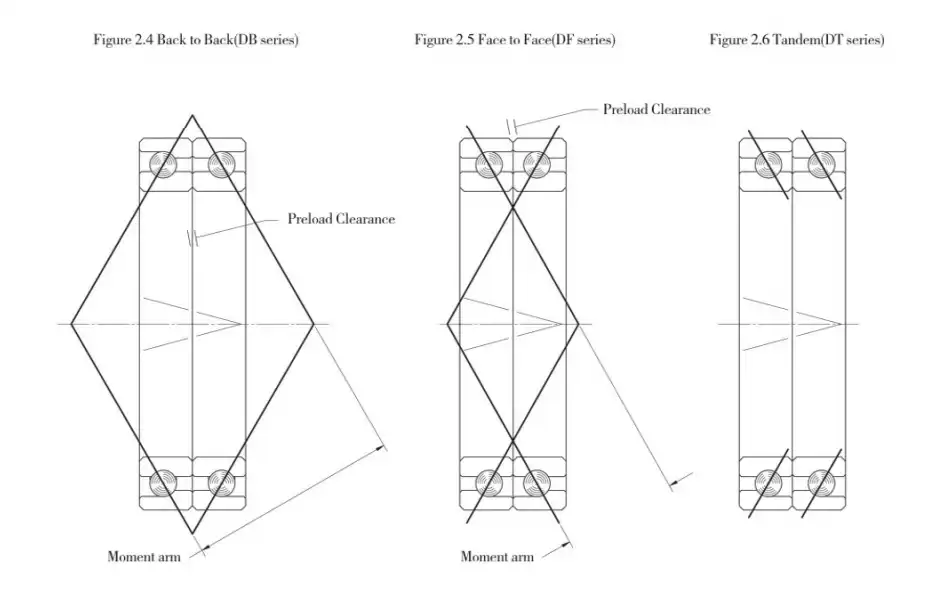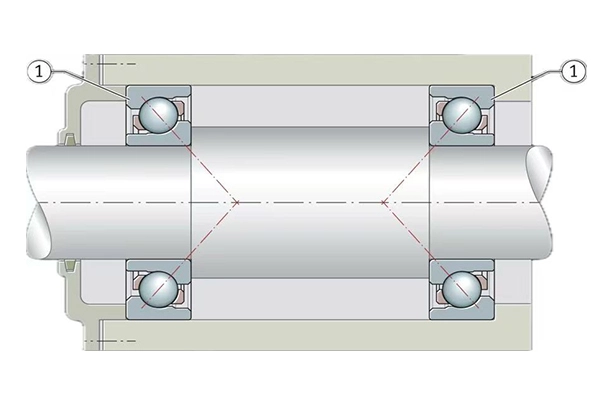How Do You Choose The Right Precision Angular Contact Ball Bearing?
Selecting the appropriate precision angular contact ball bearing is a critical decision that can significantly impact the performance, efficiency, and longevity of your mechanical system. These specialized bearings play a crucial role in various high-precision applications, from machine tool spindles to aerospace components. In this comprehensive guide, we'll explore the key factors to consider when choosing precision angular contact ball bearings, compare them to other bearing types, and discuss the applications where they excel.

What are the key factors to consider when selecting precision angular contact ball bearings?
When it comes to choosing the right precision angular contact ball bearing, several crucial factors come into play. Each of these elements contributes to the bearing's performance and suitability for specific applications. Let's delve into these key considerations:
1. Load Capacity and Direction:
One of the primary considerations in selecting a precision angular contact ball bearing is its load capacity. These bearings are designed to handle both radial and axial loads simultaneously, making them versatile for various applications. When evaluating load capacity, consider:
- Radial load: The force perpendicular to the shaft axis
- Axial load: The force parallel to the shaft axis
- Combined load: The bearing's ability to handle both radial and axial loads concurrently
It's essential to accurately calculate the expected loads in your application and choose a bearing with appropriate load ratings to ensure optimal performance and longevity.
2. Contact Angle:
The contact angle is a defining characteristic of angular contact ball bearings. It refers to the angle between the line joining the points of contact of the ball and the raceways in the radial plane, along which the load is transmitted from one raceway to another. Common contact angles include 15°, 25°, and 40°. Consider the following:
- Smaller angles (e.g., 15°): Offer higher radial load capacity and are suitable for high-speed applications
- Larger angles (e.g., 40°): Provide greater axial load capacity and increased stiffness
Choose the contact angle that best aligns with your application's load and speed requirements.
3. Precision Grade:
Precision angular contact ball bearings are available in various precision grades, typically defined by ABEC (Annular Bearing Engineering Committee) or ISO standards. Higher precision grades offer tighter tolerances but come at a higher cost. Consider:
- ABEC 7 or 9 (ISO P4 or P2): For applications requiring the highest precision, such as machine tool spindles
- ABEC 5 (ISO P5): For general high-precision applications
- ABEC 3 or 1 (ISO Normal): For less demanding applications
Select the precision grade that meets your application's accuracy requirements without overspecifying.
How do precision angular contact bearings compare to other types of ball bearings?

Precision angular contact ball bearings have unique characteristics that set them apart from other bearing types. Understanding these differences is crucial for selecting the most appropriate bearing for your application. Let's compare precision angular contact bearings to other common ball bearing types:
1. Precision Angular Contact vs. Deep Groove Ball Bearings:
Deep groove ball bearings are one of the most common bearing types, known for their versatility and ease of use. However, precision angular contact bearings offer several advantages in specific applications:
- Load handling: While deep groove bearings excel at radial loads, angular contact bearings can handle combined radial and axial loads more effectively.
- Speed capability: Angular contact bearings generally have higher speed ratings due to their ability to manage heat generation more efficiently.
- Precision: Angular contact bearings can achieve higher precision levels, making them suitable for applications requiring tighter tolerances.
- Stiffness: The preload capability of angular contact bearings allows for increased system stiffness, which is crucial in machine tool applications.
However, deep groove bearings may be preferable in applications with purely radial loads or where simplicity and cost-effectiveness are primary concerns.
2. Precision Angular Contact vs. Tapered Roller Bearings:
Tapered roller bearings are known for their high load capacity and ability to handle combined loads. Comparing them to precision angular contact bearings:
- Load capacity: Tapered roller bearings generally have higher load capacities, especially for heavy-duty applications.
- Speed: Precision angular contact bearings typically offer higher speed capabilities due to their ball design and lower friction.
- Precision: Angular contact bearings can achieve higher precision levels, making them more suitable for high-accuracy applications.
- Separability: Both bearing types offer separable inner and outer rings, facilitating easier maintenance.
Choose precision angular contact bearings when high speed and precision are priorities, and tapered roller bearings when maximum load capacity is the primary concern.
3. Precision Angular Contact vs. Cylindrical Roller Bearings:
Cylindrical roller bearings are known for their high radial load capacity and ability to accommodate misalignment. Comparing them to precision angular contact bearings:
- Load handling: Cylindrical roller bearings excel at pure radial loads but have limited axial load capacity. Angular contact bearings offer better combined load handling.
- Speed: Both bearing types can achieve high speeds, with angular contact bearings often having a slight edge in extreme high-speed applications.
- Stiffness: Angular contact bearings can provide higher system stiffness when properly preloaded.
- Precision: Angular contact bearings generally offer higher precision levels, especially in axial positioning.
Opt for precision angular contact bearings when combined loads and high precision are required, and cylindrical roller bearings for applications with heavy radial loads and potential misalignment.
Choose precision angular contact bearings for high-speed, high-precision applications, and four-point contact bearings for simpler installations requiring bidirectional axial load support.
By understanding these comparisons, you can make an informed decision when selecting between precision angular contact ball bearings and other bearing types for your specific application.
What applications are best suited for precision angular contact ball bearings?

Precision angular contact ball bearings excel in a wide range of applications that demand high accuracy, speed, and the ability to handle combined loads. Their unique design makes them particularly well-suited for certain industries and specific use cases. Let's explore the applications where precision angular contact ball bearings shine:
1. Machine Tool Spindles:
One of the most common and demanding applications for precision angular contact ball bearings is in machine tool spindles. These bearings are crucial in ensuring the accuracy and performance of various machining operations:
- CNC milling machines: Angular contact bearings support high-speed spindles, providing the necessary stiffness and precision for accurate milling operations.
- Grinding machines: The high precision and speed capabilities of these bearings make them ideal for both external and internal grinding applications.
- Turning centers: Angular contact bearings ensure the accuracy of the spindle, critical for producing precise cylindrical parts.
- Drilling and boring machines: The ability to handle combined loads makes these bearings suitable for supporting drill and boring spindles.
In machine tool applications, precision angular contact bearings are often used in matched sets (duplex or triplex arrangements) to maximize stiffness and load capacity.
2. Aerospace and Aviation:
The aerospace industry relies heavily on precision angular contact ball bearings for various critical applications:
- Jet engine components: These bearings support high-speed shafts in turbines and compressors, withstanding extreme temperatures and loads.
- Gearboxes: Angular contact bearings ensure precise gear meshing and support in aircraft transmission systems.
- Control surface actuators: The bearings' ability to handle combined loads makes them suitable for supporting control surface mechanisms.
- Auxiliary power units (APUs): Precision bearings support high-speed rotors in APUs, ensuring reliable power generation.
The high reliability, precision, and performance of angular contact bearings make them indispensable in aerospace applications where failure is not an option.
3. Medical and Dental Equipment:
Precision angular contact ball bearings play a crucial role in various medical and dental devices:
- Dental drills: High-speed, precision bearings ensure accurate and smooth operation of dental handpieces.
- Medical centrifuges: Angular contact bearings support high-speed rotors, crucial for separating blood components and other laboratory processes.
- Medical imaging equipment: These bearings support rotating components in CT scanners and MRI machines, ensuring precise imaging.
- Surgical tools: High-precision bearings are used in various powered surgical instruments, providing smooth and accurate operation.
The cleanliness, precision, and reliability of these bearings make them ideal for medical applications where sterility and accuracy are paramount.
4. Robotics and Automation:
The robotics and automation industry relies on precision angular contact ball bearings for various applications:
- Robot arm joints: These bearings provide the necessary precision and load-handling capabilities for robot arm movements.
- End-effector mechanisms: Angular contact bearings support precise positioning and movement of robot end-effectors.
- Automated assembly lines: High-speed, precision bearings are used in various components of automated assembly systems.
- Packaging machinery: The bearings support high-speed rotating components in packaging equipment, ensuring accuracy and efficiency.
The combination of high precision, speed capability, and load handling makes these bearings ideal for the demanding world of robotics and automation.
5. Semiconductor Manufacturing Equipment:
The semiconductor industry requires ultra-high precision in its manufacturing processes, making precision angular contact ball bearings essential:
- Wafer handling robots: These bearings support precise movements in wafer transfer mechanisms.
- Lithography equipment: Angular contact bearings ensure accurate positioning of optical components in photolithography systems.
- Chemical Mechanical Planarization (CMP) machines: High-precision bearings support polishing heads, ensuring uniform material removal.
- Inspection and testing equipment: Precision bearings support various rotating and positioning components in semiconductor inspection systems.
The cleanliness, precision, and reliability of these bearings are crucial in maintaining the stringent standards of semiconductor manufacturing.
By understanding the diverse applications where precision angular contact ball bearings excel, you can better appreciate their importance in various industries and make informed decisions when selecting bearings for your specific needs.
In conclusion, choosing the right precision angular contact ball bearing requires careful consideration of various factors, including load requirements, speed capabilities, precision needs, and environmental conditions. By understanding the unique characteristics of these bearings and how they compare to other bearing types, you can select the optimal solution for your application. Whether you're designing a high-speed machine tool spindle, a medical device, or a robotic system, precision angular contact ball bearings offer the performance, reliability, and accuracy needed to drive innovation and efficiency across numerous industries.
Luoyang Huigong Bearing Technology Co., Ltd. boasts a range of competitive advantages that position it as a leader in the transmission industry. Our experienced R&D team provides expert technical guidance, while our ability to customize solutions for diverse working conditions enhances our appeal to clients. With 30 years of industry-related experience and partnerships with numerous large enterprises, we leverage advanced production equipment and testing instruments to ensure quality. Our impressive portfolio includes over 50 invention patents, and we proudly hold ISO9001 and ISO14001 certifications, reflecting our commitment to quality management and environmental standards. Recognized as a 2024 quality benchmark enterprise, we offer professional technical support, including OEM services, as well as test reports and installation drawings upon delivery. Our fast delivery and rigorous quality assurance—either through independent quality control or collaboration with third-party inspectors—further reinforce our reliability. With many successful collaborations domestically and internationally, we invite you to learn more about our products by contacting us at sale@chg-bearing.com or calling our hotline at +86-0379-65793878.
References:
1. SKF Group. (2021). Angular contact ball bearings.
2. NSK Ltd. (2021). Precision Angular Contact Ball Bearings.
3. Schaeffler Technologies AG & Co. KG. (2021). Angular contact ball bearings.
4. NTN Corporation. (2021). Angular Contact Ball Bearings.
5. The Timken Company. (2021). Precision Bearings Catalog.
6. JTEKT Corporation. (2021). Precision Bearings.
7. American Bearing Manufacturers Association. (2021). Load Ratings & Fatigue Life for Ball Bearings.
8. International Organization for Standardization. (2018). ISO 492:2014 Rolling bearings — Radial bearings — Geometrical product specifications (GPS) and tolerance values.

